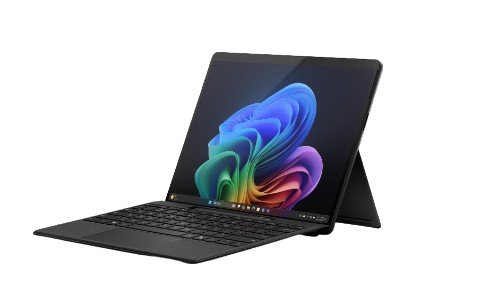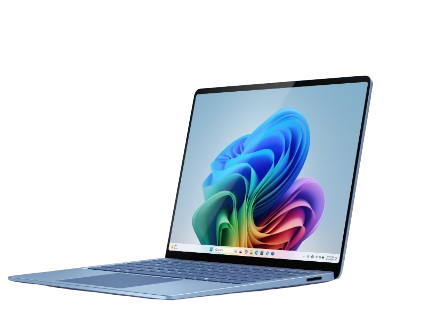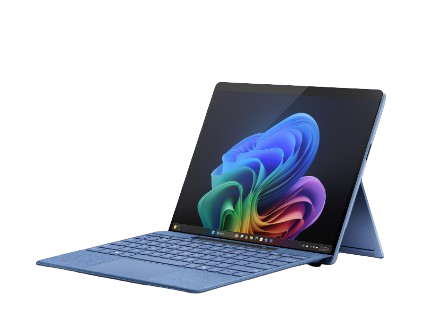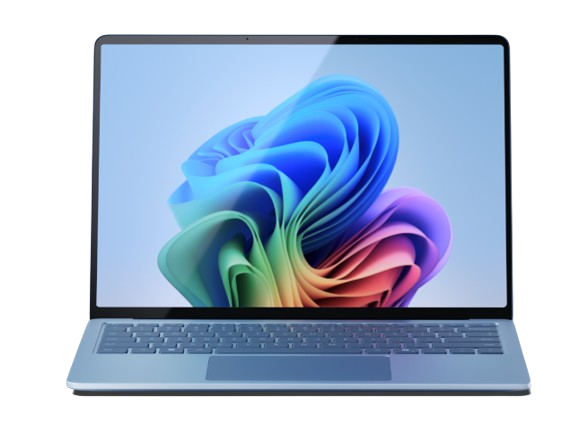In today’s highly competitive laptop market, Microsoft’s Surface Laptop has managed to carve out a unique space for itself. Known for its elegant design, premium feel, and solid performance, it competes against some of the biggest names in the industry, including Apple’s MacBook series, Dell’s XPS line, and Lenovo’s ThinkPad. But how does the Surface Laptop fare against its competitors in terms of performance, design, battery life, and value for money? In this article, we’ll compare the Surface Laptop to its key competitors to help you decide which one is truly the best choice for you.
1. Design & Build Quality
Surface Laptop:

- The Surface Laptop has earned praise for its sleek, minimalist design. With a premium aluminum body and Alcantara fabric keyboard option, it exudes sophistication.
- Its display is one of its standout features, with a PixelSense touchscreen offering stunning color accuracy and brightness. The thin bezels make it look modern and upscale.
- Weight: Around 2.79 pounds (1.27 kg), making it light enough for portability but not the lightest in its class.
Apple MacBook Air/Pro:
- Apple’s MacBook models, especially the MacBook Air and MacBook Pro, are known for their ultra-slim design and excellent build quality. Made from a single piece of aluminum, they offer a sleek, minimal aesthetic that rivals the Surface Laptop.
- The MacBook Air weighs in at 2.8 pounds (1.29 kg) and is slightly thinner than the Surface Laptop, but the MacBook Pro models are heavier.
- Apple’s Retina display is revered for its sharpness, and the MacBook Air M2 offers excellent color accuracy, much like the Surface Laptop’s PixelSense.
Dell XPS 13/15:

- Dell’s XPS 13 is also known for its stunning InfinityEdge display, which reduces bezels to an almost non-existent level. It’s one of the most attractive designs in the ultrabook category.
- The build quality is premium, with a combination of aluminum and carbon fiber materials.
- Weight: Around 2.64 pounds (1.2 kg) for the XPS 13, making it slightly lighter than the Surface Laptop.
Lenovo ThinkPad X1 Carbon:
- The ThinkPad X1 Carbon has a reputation for being incredibly durable, thanks to its carbon fiber body. It joins a business-situated plan with present day style.Its keyboard is highly regarded as one of the best on any laptop, making it ideal for professionals who type a lot.
- Weight: Around 2.4 pounds (1.09 kg), making it one of the lightest and most portable premium laptops.
Winner: Apple MacBook Air / Dell XPS 13
- While the Surface Laptop offers excellent design and craftsmanship, the MacBook Air and Dell XPS 13 take the crown when it comes to portability and aesthetics.
2. Performance
Surface Laptop:

- The Surface Laptop features Intel Core i5 or i7 processors (12th Gen as of the latest models), providing solid performance for day-to-day tasks like web browsing, document editing, and media consumption.
- The device also offers up to 32GB of RAM and up to 1TB of SSD storage, making it powerful enough for multitasking and running demanding applications.
- It comes with integrated Intel Iris Xe graphics, meaning it’s decent for light photo and video editing, but not ideal for gaming or intensive graphics work.
Apple MacBook Air (M2):
- Powered by Apple’s M2 chip, the MacBook Air offers impressive performance for most tasks, including heavy multitasking, video editing, and content creation. The M2 chip outperforms many Intel-based laptops in terms of energy efficiency and raw power.
- RAM options go up to 16GB, which is more than sufficient for most users.
- Integrated Apple GPU ensures smoother performance for creative tasks like video editing and 3D rendering.
Dell XPS 13 (13th Gen Intel):
- The Dell XPS 13 is equipped with Intel’s latest 13th Gen Core processors (up to i7), delivering superb performance for a variety of tasks.
- You can configure the laptop with up to 32GB of RAM and 1TB of SSD storage, making it capable of handling multitasking, moderate gaming, and creative work.
- Intel Iris Xe graphics are standard, and while not designed for heavy gaming, they offer decent performance for casual gamers.
Lenovo ThinkPad X1 Carbon (Intel 13th Gen):

- The ThinkPad X1 Carbon is known for its high-end performance, with Intel Core i5 and i7 processors from the 13th Gen series.
- With configurations offering up to 32GB of RAM and 1TB SSD, it’s built for professional work, including data analysis, programming, and enterprise applications.
- Integrated Intel Iris Xe graphics work well for light creative tasks but won’t excel in gaming or high-end graphics workloads.
Winner: Apple MacBook Air M2
- The MacBook Air M2 outperforms its rivals in terms of raw processing power, particularly with its custom-built Apple silicon. It’s the best option for users who need a high-performance machine for creative and professional work.
Frequently Asked Questions (FAQ) – Surface Laptop vs Competitors
1. Which laptop is better for productivity: Surface Laptop, MacBook Air, or Dell XPS 13?
MacBook Air (M2) is a great choice for productivity due to its long battery life, efficient performance, and lightweight design. It handles multitasking well and is ideal for users who need to work on-the-go.
Surface Laptop is also a strong contender for productivity, especially with its gorgeous display and comfortable keyboard. However, it’s slightly heavier than the MacBook Air.
Dell XPS 13 is perfect for those who prefer Windows and need solid performance in a compact form factor. It is excellent for productivity tasks but doesn’t quite match the MacBook Air’s battery life.
2. Is the Surface Laptop good for gaming?
The Surface Laptop is not designed for gaming. While it has integrated Intel Iris Xe graphics, it can handle light gaming and casual titles, but it won’t support graphically intensive games like AAA titles. For gaming, you might want to look at a dedicated gaming laptop with a discrete GPU
3. Does the Surface Laptop have a touchscreen?
Yes, the Surface Laptop features a PixelSense touchscreen display, offering sharp visuals and vibrant colors. This is one of the key features that sets it apart from many of its competitors.
4. Which laptop has the best battery life: Surface Laptop, MacBook Air, or ThinkPad X1 Carbon?
The MacBook Air M2 has the longest battery life, offering up to 18 hours of use on a single charge, making it the best for users who prioritize all-day battery performance.
The ThinkPad X1 Carbon is another strong contender with up to 15 hours of battery life, especially in business configurations.
The Surface Laptop offers around 11-12 hours of battery life, which is good but not as long-lasting as the MacBook Air.
5. Is the MacBook Air M2 better than the Surface PC for inventive work?
For creative work such as video editing, photo manipulation, and graphic design, the MacBook Air M2 offers superior performance thanks to the Apple M2 chip and its integrated GPU. It handles demanding applications efficiently.
The Surface Laptop can also handle creative tasks but may not be as fast or powerful as the MacBook Air in some workflows, especially when dealing with intensive video editing or 3D rendering.
6. Can I upgrade the RAM or storage on the Surface Laptop?
No, the Surface Laptop has non-upgradable RAM and storage, so you’ll need to select the configuration that suits your needs when purchasing. It’s best to choose a model with enough RAM and storage for your future requirements.
7. How does the Surface Laptop compare in terms of pricing?
The Surface Laptop starts at approximately $999 for the entry-level model. Higher-end configurations with more RAM and storage can cost up to $2,000+.
The MacBook Air M2 starts at around $1,099, but it often offers better value for the performance and battery life you get.
The Dell XPS 13 starts at $999 and can go up to $1,500 or more for higher-end configurations.
The ThinkPad X1 Carbon starts at about $1,300, with high-end models reaching $2,000.
8. Which laptop has the best display for content creation?
The MacBook Air M2 and Surface Laptop both feature excellent displays, with true-to-life color reproduction and high resolution, making them ideal for content creation tasks.
The MacBook Air M2 has a 13.6-inch Retina display with True Tone technology, providing highly accurate colors.
The Surface Laptop has a 13.5-inch PixelSense touchscreen, known for its vibrant color accuracy, making it an excellent choice for photo and video editors.
The Dell XPS 13 has a sharp 4K option (in higher configurations), and the ThinkPad X1 Carbon offers excellent color accuracy, but its focus is more on business use than creative work.
9. Which laptop is better for business use: Surface Laptop, MacBook Air, or ThinkPad X1 Carbon?
For business users, the ThinkPad X1 Carbon is the clear winner. It’s built for the enterprise environment with top-tier durability, excellent keyboards, and business-centric features like a privacy screen option, fingerprint reader, and IR camera.
The Surface Laptop is also a good choice for business professionals, especially if you need something stylish and capable of handling most office tasks.
The MacBook Air is a great option for business users who are integrated into the Apple ecosystem or need high portability and long battery life. However, it lacks some of the advanced business features of the ThinkPad X1 Carbon.
10. Is the Surface Laptop suitable for students?
Yes, the Surface Laptop is a great choice for students. It’s lightweight, has a premium build, and offers excellent performance for note-taking, research, and light multimedia tasks. The touch-screen feature is also a bonus for interactive learning.
If you need something more budget-friendly, the MacBook Air M2 or Dell XPS 13 could be good alternatives depending on your operating system preference and performance needs.